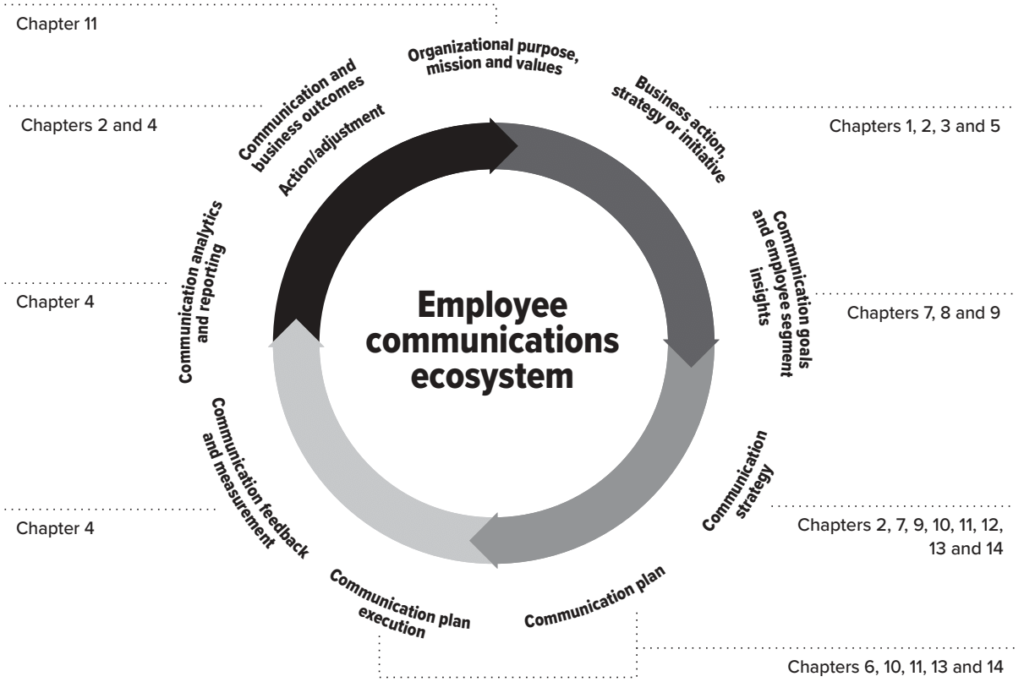Get Your Copy Of The Engaging Employees Through Strategic Communication Book Or Contact North Star Communications Today

The Employee Communications Ecosystem diagram above shows the different topics covered in the book Engaging Employees Through Strategic Communication by Mark Dollins and Jon Stemmle. Take advantage of the opportunity to enhance your organizational communication strategy and engage your employees effectively by getting your hands on the highly recommended book! Piqued your curiosity? Want to know why change communications, Block Chain, Artificial Intelligence and employee activism will shape our near-term future? Visit engage-employees.com to grab your copy today. To read about the topics covered in the book read on.
Chapter Content
SECTION 1: OVERVIEW OF EMPLOYEE COMMUNICATION & MARKET NEEDS
Chapter 1: Defining employee communication and its history
In this chapter, we define the origins of employee communications, articulate the value it delivers to organizations (for profit, not-for profit) and provide an overview of the skills or competencies required to be effective with this communications discipline. We’ll also talk about the influence and interdependency of other communications disciplines on how it is deployed in an organization, and how other influences (such as reporting relationship, budget and other resources, and team structure) drive its influence in any organization.
Chapter 2: What makes employee communication strategic?
Apart from the tools and skills required for effective employee communications, making those efforts truly strategic demands unique, relevant insights from stakeholders, clarity on success measures, creative ideas and clear messaging that sticks. In this chapter, we share how all of those priorities must be woven together in a strategy that delivers clear and compelling results. It also will acknowledge the importance of flexibility and creativity in addressing internal and external influences that invariably drive the ability to execute a strategy, and still deliver intended results.
Chapter 3: Competencies for employee communication
While some skill sets for employee communications are consistent with other/externally-focused disciplines, we also explore competencies that are unique to employee communications professionals, and provide insights into how internal and external communications skill sets ultimately produce the most effective employee communicators. The need for some skill sets, particular those with social media, are evolving quickly with internal stakeholders, and we will highlight how those skill sets, and an increasing knowledge of technology platforms, will be a key enabler of career growth in this space
SECTION 2: APPLYING EMPLOYEE COMMUNICATION STRATEGICALLY
Chapter 4: Employee communication measurement
Whether an organization is for profit or not, it’s critical than any communication effort to “internal stakeholders” deliver on expected results for the enterprise. In this chapter, we answer the question: “How do we measure the impact of employee communications.” We look at metrics such as awareness, understanding and belief as content-based metrics; digital metrics that, in many cases, mirror external social media metrics, and look at HR-based metrics that reflect how internal communications efforts move the dial on performance.
We will introduce tools and methodologies needed to produce a 360-degree view of what’s working and why. And we will cover the importance of translating data into reporting leads to actionable decision making.
Chapter 5: Influences on employee communication
Where employee communications reports influences how it is managed, and how it interacts with other communications should be more than a check-the-box activity. This chapter will present insights on the influences of functions such as HR, Marketing and Legal can have on how employee communications are managed. The interactivity and interdependencies with other communications functions, are equally critical, and we will introduce the concept of the increasingly invisible wall between internal and external communications — and the opportunities and risks that this particular dynamic can make available.
Chapter 6: Ethics and compliance
Communicating internally in an ethical way — and in compliance with laws across the globe — isn’t negotiable; it’s table stakes. In this chapter, we will cover not only the legislative and regulatory requirements when communicating with employees, but the increasing need for transparency and candor. More recent examples of employee activism (Google’s global employee walk out over management’s handling of sexual misconduct in the management ranks) highlight why doing the business the right way — and communicating effectively — has significant consequences for internal stakeholders as well as customers and shareholders. It’s not just what is communicated inside the enterprise, but how and by whom.
Chapter 7: Internal segmentation
One size doesn’t fit all when it comes to employee engagement. Empowering middle and senior leaders, and other key influencers to drive change with communications increasingly is a strategy that must be deployed for effective engagement strategies. In this chapter, we will provide an overview of how to segment internal stakeholders, how to assess the unique needs of each cohort, and how to build measurement and reporting that will drive effective execution.
Chapter 8: Channel auditing, assessment and launches
The best-laid plans and best-prepared content won’t work if it/they don’t or can’t reach their intended internal audiences. In this chapter we’ll explore the critical partnership needed between communicators, IT function leaders, Human Resources and Legal to examine everything from technology limitations to governance and capital investments to reach increasingly mobile and diverse employee bases. Assumptions about hitting the “send” or “post” button — when it comes to reaching employees — often are met with the harsh reality of issues with technology or policies that needed to be reviewed. We introduce ways of auditing existing channels, assessing needs for new channels — before a crisis emerges, and a critical capability is not available.
Chapter 9: Executive communication
The C-Suite’s influence through communications with internal stakeholders is among the strongest that any enterprise has. While CEO’s clearly must address a wide range of external and internal stakeholders in running their organizations, the responsibility for advising on strategy, messaging, tone, feedback and channel delivery falls most often with the employee communications leader. In this chapter, we will explore how employee communications professionals shape the CEO and C-Suite’s internal communications agenda, and earn the role of trusted advisor while representing the voice — and communication needs — of the employee. Executive and Employee Communications often are structured together in communications organization — making this area of expertise critical for employee communications professionals who want to continue growing and becoming more influential in their roles.
SECTION 3: CHANGE MANAGEMENT AND EMPLOYEE COMMUNICATION
Chapter 10: Change management: The emerging internal communication expertise
The rapid explosion of Change Management Offices (CMOs) in organizations across the globe is proof positive that the discipline of managing change is here to stay. Typically housed in the Human Resources function, HR leaders are tasked with enabling management to drive large-scale change agendas. The key enabler of success is a comprehensive change management communications discipline. HR increasingly is looking to Communications functions to supply that expertise. Understanding change management models such as ADKAR, Lewin’s Change Management Model and Kotter’s theory, among others, presents communicators with unique opportunities to build strategies, channels and content, and this chapter will provide a clear view of to align communications with change strategies.
Chapter 11: Storytelling: Engaging hearts with heads
Change management may sound uninspiring to many, but through effective storytelling — a core communications competency — it can make the difference between broadcasting an idea versus empowering employees to live its promise. In this chapter we introduce the critical purpose of a master narrative, the importance of proof points/smaller stories to continue moving the organization and help it see progress in the story, and the skill base that leaders must develop to translate a corporate journey credibly and transparently into motivation.
Chapter 12: The evolution of employee communication to employee engagement.
Unlike the early days of employee communications — which deployed static/broadcast media and methodologies — contemporary employee communications have evolved to much more dynamic models. In this chapter, we explore why, and how, today’s successful employee communications capabilities are reliant on constant feedback loops, multi-directional communication models, measurement, analytics and reporting. At the same time, we introduce the importance of traditional communications competencies in helping communicators balance both the art and science of communication to internal stakeholders. We illustrate how this evolving discipline is more directly being deployed to business drivers such as organizational health and employee engagement.
SECTION 4: CURRENT AND FUTURE TRENDS
Chapter 13: Beyond change: Other employee communication roles
While change management and general employee engagement in business priorities are big focus areas for employee communicators, there are several more areas that increasingly are engaging professionals in this space. In this chapter, we explore four specialized employee communicator roles: HR Finance, Information Technology (IT), and finally, we a ubiquitous role that every employee communicator must fill: the consultant.
Chapter 14: Current & future forces shaping employee communication
Like any communication discipline, market place forces are driving new, complex issues and problems to solve. In this chapter we’ll examine three of the biggest forces that will demand time, energy, focus and strategic assessment for employee communicators: technology, the rising voice of the employee and the influence of distance (with more remote workers) on how communications to employees are conceived and executed. Each of these influences exist in today’s marketplace, and will continue to grow in scale — and importance.


